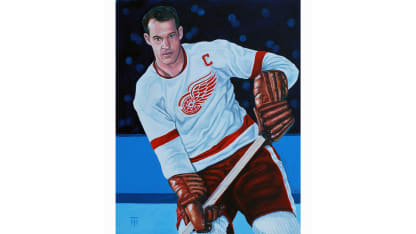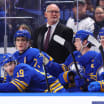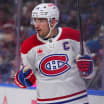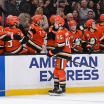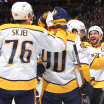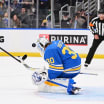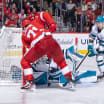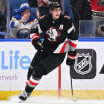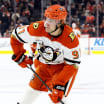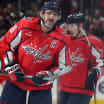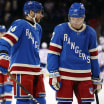As part of the NHL Centennial Celebration, renowned Canadian artist Tony Harris will paint original portraits of each of the 100 Greatest NHL Players presented by Molson Canadian as chosen by a Blue Ribbon panel.
NHL.com will reveal the final 10 portraits this week, starting with those of center Wayne Gretzky and forward Gordie Howe on Monday in the 46th installment.
Gretzky, Howe portraits unveiled
Final 10 color paintings of 100 Greatest NHL Players will be revealed on NHL.com this week
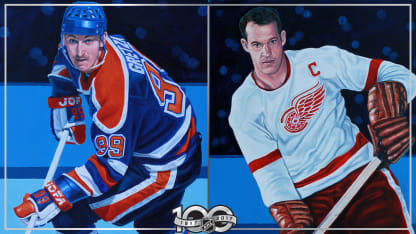
By
NHL.com @NHLdotcom
Based purely on numbers, there's no doubt that Wayne Gretzky is the greatest player in NHL history. He sits so far atop almost every meaningful offensive category that it's impossible to see anyone catching him. When Gretzky retired in 1999, he owned 61 NHL records, including the single-season marks for goals (92), assists (163) and points (215). Take away his NHL-record 894 goals and he'd still be No. 1 all-time in scoring; Gretzky has more career assists (1,963) than any other player has points.
His nickname, The Great One, truly fit.
Gretzky powered the Edmonton Oilers to the Stanley Cup four times in five seasons, won the Hart Trophy as most valuable player nine times, the scoring title 10 times, the Conn Smythe Trophy as playoff MVP twice, and the Lady Byng Trophy and Ted Lindsay Award five times each. After being traded to the Los Angeles Kings by the Oilers on Aug. 9, 1988, Gretzky brought hockey into the forefront of sports in southern California, where it had taken a back seat for most of two decades.
To watch Gretzky on the ice was like watching a great artist at work, except that for No. 99, his canvas was a 200-by-85 sheet of ice where he always seemed to be three steps ahead of the opposition. Despite a physique that was generously listed as 6-foot, 185 pounds, he defied almost every law of hockey, turning the game into an exhibition of speed and skill the likes of which no one had ever seen.
Gretzky turned the area behind the net into his "office," setting up plays and creating space for teammates. He made the player coming late into the offensive zone dangerous because of his ability to hold onto the puck without turning it over.
In his
NHL100 profile of Gretzky
, NHL.com columnist Dave Stubbs looked at No. 99's youth hockey years, when he first started putting up the incredible numbers that became commonplace.
"His love of hockey began when, as a 2-year-old in his hometown of Brantford, Ontario, he was taken for a skate by his father on the Nith River below his grandparents' nearby farm. On this river and on wind-swept community rinks well after dark, Walter Gretzky watched his son until he could freeze no more. In self-preservation, he would build perhaps the world's most famous backyard rink, young Wayne skating on it morning, noon and night, aimed squarely at superstardom.
"By age 5, Gretzky was playing for the Brantford novice-class all-star team, which included players five and six years his senior. A year later, he was trying out for his first real team with boys still much his elder, arriving at the rink with a bundle of nerves and a bushel of talent.
"Gretzky scored just one goal with that team, the trainer giving him the puck and saying, 'You'll score a lot more than this, but here's the first one.'
"By age 13, Gretzky had scored more than 1,000 goals in minor hockey, getting 27 in his second season, then 104, with 63 assists, in his third.
"Turning 10 in 1970-71, he scored 196 goals with 120 assists in 76 games. If Gretzky's body wasn't sprouting, his talent was skyrocketing. In his final season of peewee, wearing the No. 9 of his NHL idol, Gordie Howe, spanning ages 10 and 11, the 4-foot-10, 70-pound Gretzky scored 378 goals with 139 assists in 85 games as captain of the Brantford Nadrofsky Steelers.
"That was followed by league-leading seasons of 105, 192 and 90 goals, against tougher, older competition, the youngster by now a celebrity across the land. A wonderful baseball and lacrosse player when he wasn't on skates, he also was silky smooth with the media when barely into his teens, a skill that would come in handy.
"Gretzky would meet Howe, the Detroit Red Wings icon, in a limousine on the way to Brantford's 1972 Kiwanis Club Great Men of Sports dinner, starstruck into silence. Mr. Hockey would remind Gretzky, fresh off his 378-goal peewee season, of the importance of working on his backhand. It likely was not by coincidence that Gretzky's first goals in Junior B, Junior A, the WHA and the NHL, and the goal on Oct. 15, 1989, that gave him his 1,851st point -- on which he passed Howe for the all-time NHL lead with the latter proudly watching -- all came on backhands."
Painting Gretzky's portrait reminded artist Tony Harris of what a thrill it was to have watched him play.
"When I was a kid my friends started to hear rumors about a young player named Gretzky who scored 400 goals in peewee hockey -- and even more outrageous, he wore white gloves. Both turned out to be true," he said. "Painting Wayne's portrait reminded me of how amazingly incomprehensible his accomplishments were in the NHL and how lucky my generation is to have witnessed it."
Like Gretzky, Howe's nickname fit him perfectly. Just as no one else could be Gretzky, there was only one Mr. Hockey.
After all, how many players in any sport could take a regular turn at age 52? That's what Howe did with the Hartford Whalers in 1979-80, nine years after he retired (for the first time) following 25 seasons with the Detroit Red Wings. By then, he was skating with his sons Mark and Marty, who had joined him with the Houston Aeros of the World Hockey Association in 1973 and accompanied him to the NHL when the Whalers were admitted in 1979.
Howe's physical style was the direct opposite of Gretzky's; his toughness was legendary. But like Gretzky, Howe's numbers - the four Stanley Cup championships, the six Hart and Art Ross trophies he won, 20 consecutive seasons in the top five of the NHL scoring race -- are only part of the story. His greatest gift was his human touch. Howe had the ability to make star struck fans of any age feel at ease. The aw-shucks demeanor that the native of Floral, Saskatchewan, brought with him to Detroit when he joined the Red Wings in 1946 never left him.
Howe was immensely popular wherever he went, especially in Detroit. He always had time for fans, signed countless autographs and was involved in numerous charitable causes.
Gretzky, who admitted feeling some guilt about expunging his idol's offensive marks from the NHL record book, called Howe "the greatest player ever."
In his
NHL100 profile of Howe
, Stubbs described the genesis of Mr. Hockey's career:
"Howe was born in tiny Floral, Saskatchewan, on March 31, 1928, soon before the Great Depression, one of nine children raised by his parents, Ab and Kate. The family moved to nearby Saskatoon when Howe was an infant, and he fell in love with hockey when he laced up his first pair of skates, a battered pair of boots and blades that were dropped in the Howe kitchen in a sack of odds and ends by a destitute woman seeking a dollar or two.
"Howe was 8 when he arrived in organized hockey, his spine weakened by a calcium deficiency. But his tremendous devotion to exercise and summers spent working for his father, a laborer, built the powerful physique that he would use to his complete advantage throughout his illustrious career.
"A tryout in Winnipeg with the New York Rangers at age 15 ended unsuccessfully, with Howe yearning for home, and he was signed by the Detroit Red Wings the following year. He attended school in Galt, Ontario, practicing with Detroit's junior team there, then turned pro at 17 with Omaha of the United States Hockey League.
"Howe made his NHL debut as an 18-year-old on Oct. 16, 1946, scoring once and fighting twice. His reputation for toughness was built early and tested often. In time, Howe learned to stop looking for trouble but never backed down when it knocked on his door; a crushing, legendary, multipunch dismantling of Rangers heavyweight Lou Fontinato in 1959 proved once and for all that it'd be best to not get under Mr. Hockey's skin."
Harris had the entirety of Howe's career to choose from but chose to use the image of Mr. Hockey in his younger years.
"Gordie Howe is hockey royalty, which adds a bit of pressure to finding the right image befitting a king," he said. "For me, this young version of Mr. Hockey shows his incredible strength and presence on the ice, where he dominated for decades to come."
Wayne Gretzky
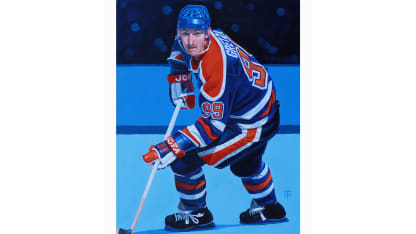
Gordie Howe
